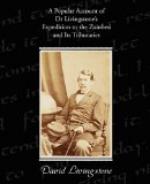We discovered Lake Nyassa a little before noon of the 16th September, 1859. Its southern end is in 14 degrees 25 minutes S. Lat., and 35 degrees 30 minutes E. Long. At this point the valley is about twelve miles wide. There are hills on both sides of the lake, but the haze from burning grass prevented us at the time from seeing far. A long time after our return from Nyassa, we received a letter from Captain R. B. Oldfield, R.N., then commanding H.M.S. “Lyra,” with the information that Dr. Roscher, an enterprising German who unfortunately lost his life in his zeal for exploration, had also reached the Lake, but on the 19th November following our discovery; and on his arrival had been informed by the natives that a party of white men were at the southern extremity. On comparing dates (16th September and 19th November) we were about two months before Dr. Roscher.
It is not known where Dr. Roscher first saw its waters; as the exact position of Nusseewa on the borders of the Lake, where he lived some time, is unknown. He was three days north-east of Nusseewa, and on the Arab road back to the usual crossing-place of the Rovuma, when he was murdered. The murderers were seized by one of the chiefs, sent to Zanzibar, and executed. He is said to have kept his discoveries to himself, with the intention of publishing in Europe the whole at once, in a splendid book of travels.
The chief of the village near the confluence of the Lake and River Shire, an old man, called Mosauka, hearing that we were sitting under a tree, came and kindly invited us to his village. He took us to a magnificent banyan-tree, of which he seemed proud. The roots had been trained down to the ground into the form of a gigantic arm-chair, without the seat. Four of us slept in the space betwixt its arms. Mosauka brought us a present of a goat and basket of meal “to comfort our hearts.” He told us that a large slave party, led by Arabs, were encamped close by. They had been up to Cazembe’s country the past year, and were on their way back, with plenty of slaves, ivory, and malachite. In a few minutes half a dozen of the leaders came over to see us. They were armed with long muskets, and, to our mind, were a villanous-looking lot. They evidently thought the same of us, for they offered several young children for sale, but, when told that we were English, showed signs of fear, and decamped during the night. On our return to the Kongone, we found that H.M.S. “Lynx” had caught some of these very slaves in a dhow; for a woman told us she first saw us at Mosauka’s, and that the Arabs had fled for fear of an uncanny sort of Basungu.




